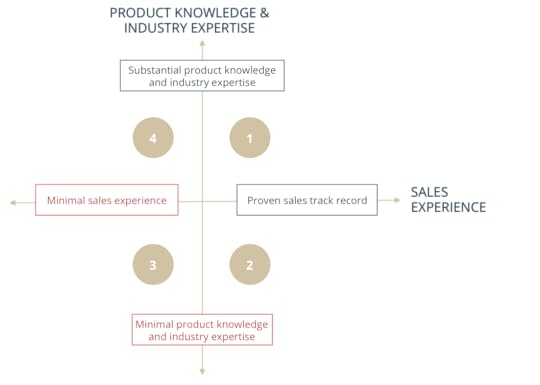Andy Paul's Blog, page 97
June 9, 2015
Sales Hiring Tip: 5 Steps To Elevate Your Sales Hiring Process
In yesterday’s article, Never Swing At The First Pitch, I stressed the need for patience in the sales hiring process. And, I identified three unproductive personas that hiring managers adopt when interviewing sales candidates that lead to bad hiring decisions.
 Today I’ll provide five steps you can use to help improve your process for identifying and qualifying the best candidates for your open sales jobs. In addition, implementing these steps will help some of the risk and uncertainty from your sales hiring process.
Today I’ll provide five steps you can use to help improve your process for identifying and qualifying the best candidates for your open sales jobs. In addition, implementing these steps will help some of the risk and uncertainty from your sales hiring process.
1. Write an accurate, honest job description.
Be very specific about the experience and expertise that a sales candidate absolutely needs in order to succeed in your sales environment. Unless you are a new company you should be familiar with the skills and experiences that the successful salespeople in your company possess. Don’t succumb to the easy temptation to write too broad of a job description. It will just waste your time by inserting unqualified candidates into your pipeline.
2. Conduct in-depth evaluations of multiple qualified candidates.
As I discussed in yesterday’s article, don’t fall in love with the first candidate you interview. Invest the time to evaluate at least two qualified candidates for every job opening you have. It means that no matter how much you like the first person you interview, you should conduct in-depth interviews and reference checks on at least one other candidate before you make the decision who to hire.
3. Interview candidates widely among your management team.
If you’re reluctant to have the rest of your team meet your favorite candidate then you know you shouldn’t hire him or her. Selling is a team sport. Hiring should be a team sport as well. Take advantage of the ‘wisdom of crowds’ effect by having multiple people from multiple departments participate in the interviews of all qualified candidates. Sales has an impact on nearly every part of your organization and it makes sense to let other departments who work with sales have input into the hiring of a sales person.
4. Test all required skills and verify all resume information.
Testing candidates on the required technical/product knowledge and sales skills that you specified in the job description is a vitally essential part of a sales hiring process. Which ever skills and experience you specified in your job description as mandatory for a candidate to have need to be tested and verified. Interviews are no place for trust. Take simple steps to test and verify that candidates actually do live up to the claims on their resume.
5. Recruit internally
The best place to recruit new salespeople is inside your own company. If your company is in a technical field, then recruit technically capable people from within your engineering and product development departments. Look for the engineers who have exhibited a special knack for customer support or the engineer that every sales person wants to use as a technical resource on a sales call. These people are already spending a chunk of their time to help prospects make decisions and you should target to recruit them into sales. Finally, consider recruiting people from your customer support team. They know your products and services inside and out and usually have a good understanding of how your customers are using them to meet their business objectives.
// ]]>
The post Sales Hiring Tip: 5 Steps To Elevate Your Sales Hiring Process appeared first on Andy Paul | Strategies to Power Growth.

June 8, 2015
Sales Hiring Tip: Never Swing At The First Pitch
Use a Little Patience At The Plate To Improve Your Sales Hiring
 Think back to your Little League days in softball or baseball. Among all the tactical wisdom you received from the various baseball dads who coached your team was this important nugget: Never swing at the first pitch.
Think back to your Little League days in softball or baseball. Among all the tactical wisdom you received from the various baseball dads who coached your team was this important nugget: Never swing at the first pitch.
The idea was that you could learn something about the tendencies and capabilities of the pitcher you faced if you sat with the bat on your shoulder and watched the first pitch cross the plate.
If you listen to radio or TV broadcasts of baseball, you’ll often hear the color commentator talk about a batter in a slightly condescending manner, describing him as “a first pitch hitter.” The implication is that the batter is being unwise by not being patient and not “working the count” until the pitcher throws a better pitch to hit.
You could fill a book arguing about whether the accepted wisdom of not swinging on a 0-0 count is a good strategy. But, there is no argument that ‘never swing at the first pitch’ is a gold standard you should integrate into your sales hiring process.
I’ve seen too many hiring managers, who lack confidence in their ability to effectively evaluate sales talent, follow the path of least resistance in interviewing and assessing sales candidates.
They typically default to one of the following three standards for hiring:
#1: The Love at First Sight Standard: This hiring manager finds the process of hiring a salesperson so uncomfortable that he or she hires the first minimally acceptable warm body that walks through the door for an interview. In this instance, the outcome is sadly predictable.
#2: The Armani Suit Standard: This hiring manager has only a generic, formulaic, motherhood and apple pie description of the skill set his company is looking for in a salesperson. Instead of hiring experience and expertise directly related to the products his or her company sells, this hiring manager values style over substance and hires sales professionals who dress well and present themselves with an extra helping of self-confidence. (And, of course, the hiring manager is later left to wonder why these people never worked out when they looked so “qualified” on paper and in person).
#3: The Interchangeable Cog Standard: This hiring manager harbors a range of emotions from slight ambivalence to outright hostility to the idea of hiring a salesperson. He or she reluctantly agrees that sales people are a necessary evil, but is so risk averse and appalled at the idea of making a mistake, and paying good money to someone who might never produce, that no one ever is good enough to fit his or her expectations. As a result, the process drags on too long and and the hiring manager relents by choosing a candidate at random on their belief that one salesperson is the pretty much the same as all others.
Identifying and qualifying the best sales candidate (that’s right, you have to qualify sales candidates just like salespeople qualify prospects) who can do the job you need done and integrate smoothly into your sales team should be the goal of your hiring efforts.
Come back tomorrow for Part 2 of this article and I’ll give you 5 easy steps you should take to improve the effectiveness of your sales hiring process.
// ]]>
The post Sales Hiring Tip: Never Swing At The First Pitch appeared first on Andy Paul | Strategies to Power Growth.

June 4, 2015
Sales Tip Video: 5 Ways To Become A More Effective Sales Coach
As a manager or executive with responsibility for sales, it’s easy to get distracted by the multiple demands on your time. You’ve got meetings to attend, reports to write and forecasts to file. It’s easier to do those things than get your hands dirty managing sales.
But, if your primary mission isn’t being a sales coach, and working with the members of your sales team to help them succeed at their jobs, then the odds are good that you won’t succeed at yours.
The fact is nothing is more important for sales managers to do than coach. What does it takes for a manager to become an effective sales coach? Click below to learn five key areas where you can really help your team. And yourself.
The post Sales Tip Video: 5 Ways To Become A More Effective Sales Coach appeared first on Andy Paul | Strategies to Power Growth.

June 2, 2015
There Are Few Absolutes In Sales. Just Things You Can Measure And Improve
Aside from the absolute necessities of honesty and integrity, there are very few absolutes in sales.
 Instead, there are questions. Lots of questions.
Instead, there are questions. Lots of questions.
One of the most important questions for you is the following: Do you have the answers you need to improve your sales productivity?
There are no right or wrong answers to that question. Just answers that reflect the current state of your sales process.
For instance, how long does it take you to help a prospect move from their initial interest to an order? You estimate that your sales cycle is 3-6 months long. But, which is it? Three months? Or six? Why does it sometimes take three months versus six months? And, why isn’t your sales cycle two months long instead of three? Are you guessing or do you know?
Or, how long does it take you to follow up a sales lead? You estimate 4 hours. But, how long does it really take until the lead is in the hands of a sales rep who will follow up? How do you know that it doesn’t take 8 hours? Is the 4 hours a measured value or an estimate?
The fact is that the answers to these questions don’t really matter. In sales, the actual answer to the question “how long is your sales cycle” is irrelevant. The same with “how long does it take to follow up a sales lead.” The only things that matter are that you collect the sales data to accurately measure the duration of your sales processes today and that you are continually working to reduce the amount of time it takes to complete them.
This holds true for every part of your sales process. If a part of your process accelerates without you knowing why, then that means that it was just an accident. And, you certainly can’t plan to grow your sales based on happy accidents.
Therefore, you have to measure everything. Every step of your sales process that contributes to the amount of time it takes a prospect to move through their buyer’s journey from their initial point of interest in your product or service to giving you the order needs to be measured. And, it needs to be analyzed to learn how you can improve it in order to reduce the amount of time it takes your prospects to complete their buying process.
Every step of your sales process requires an investment of time. And, as you know, you have a unalterably limited inventory of time with which to work. However, the answer to shortening your sales cycle may not always be to increase your speed. The point is don’t guess. Measure your process and analyze the data.
Lastly, you need to understand which of your sales process metrics correlate to increased sales success. This is an aspect that managers often miss. You can’t look at metrics as a form of quota that needs to be achieved. ‘You need to make so many calls’ or ‘You need to have so many demos.’
For your metrics, or KPIs, to be meaningful they have to directly correlate to success in terms of orders. Identify those process metrics that correlate to your important measures of success. And, then work to improve them. Improve the process and improved outcomes will follow.
The post There Are Few Absolutes In Sales. Just Things You Can Measure And Improve appeared first on Andy Paul | Strategies to Power Growth.

June 1, 2015
Perfect The Elements Of Your Selling That You Control
Do whatever is necessary to take your prospect’s breath away.
 As a salesperson, you don’t have control over many of the most crucial elements of your selling. This includes several of the key aspects that are central to developing the prospect’s perception of you, your company and your offering.
As a salesperson, you don’t have control over many of the most crucial elements of your selling. This includes several of the key aspects that are central to developing the prospect’s perception of you, your company and your offering.
You can’t control:
The completeness or quality of the solution you sell.
The pricing of the product or service you sell.
How your product is supported and serviced.
In highly competitive markets, if you want to create the thin margin of differentiation that is often the difference between winning and losing, then you have to focus on perfecting the three facets of your selling over which you have complete control.
This means maximizing your:
Responsiveness
Product Knowledge
Industry Expertise & Customer Knowledge
Let’s look at each of these in a bit more detail.
Responsiveness
Responsiveness in sales is not just about speed. To be responsive means to provide the information your prospect needs with speed. It’s about being the first seller with the answers (which dramatically improves your chances of winning the order). It’s about responding to a sales lead in Zero-Time. You can be the first seller to respond to a sales lead, but if, at the same time, you can’t deliver information that is of value to the prospect, then you aren’t being responsive.
Responsiveness is about time. It’s the easiest way to create a strongly positive first impression with your prospects. And the most important thing about responsiveness is that you have direct control over how responsive you are. The choice is up to you. Make responsiveness a priority and you’ll see an immediate change in your performance.
Product Knowledge
What prospects want most from salespeople is information. If not, why would they be talking to you? After all, if you can’t provide a level of information that is more comprehensive than what your prospects can find on the Internet by themselves, then why do they need you? As research from Forrester has found, in many cases they don’t.
You have complete control over how much product knowledge you acquire. Unfortunately, too many salespeople rely on their employers to spoon feed this knowledge to them. That’s just not enough. You have to take the initiative to continually increase the depth of understanding you have of the products you sell (and the customers you serve). Click here to read my article on the level of personal investment you need to make in your own ongoing sales education.
Industry Expertise & Customer Knowledge
What are the problems that companies in the industries you serve commonly face? How are other customers using your product or service to meet their specific needs? What are the unique ways that other companies are using and deriving value from your product and service? How are customers using your products to grow their top line, increase profits, expand market share, reduce time to market or whatever value they are receiving from their investment in your product? These are among the kind of insights that your prospects want from you.
It’s up to you how many of these insights you acquire. How much of your time are you investing to talk with your existing customers about their experiences with your product or services? How many of your more experienced colleagues are you talking with about their customers and the lessons that they have learned from them? Developing the necessary industry and customer expertise is a function both of experience and your willingness to go the extra mile to acquire this knowledge. Again, it’s up to you.
The common thread connecting the elements of your selling that you can control is time. They all relate to helping your prospects achieve one of the key objectives of their buying process: reducing the time required to gather the information they need to make a good decision.
And, if you help your prospects make faster decisions, then that creates more selling time for you. What would you do with more selling time? You’d develop more new prospects, close more orders and make more money. Of course.
To be a consistently successful salesperson you have to focus on perfecting those aspects of your selling over which you have direct control. There is nothing that can prevent you from maximizing your responsiveness, becoming extremely knowledgeable about the products you sell and acquiring valuable insights about your customers, their business and the optimal way for them to utilize your products or services. Except you. Make the choice to take your prospects’ breath away.
The post Perfect The Elements Of Your Selling That You Control appeared first on Andy Paul | Strategies to Power Growth.

May 28, 2015
3 Inconvenient Truths About Sales Training For Entrepreneurs And Owners
Which sales training mistakes are you repeating?
 I read an article about CEOs’ mistrust of sales training that caught my eye. This particular commentator cited a survey that claimed that most CEOs believed that sales training was a waste of time and money. That set me to thinking about the expectations CEOs must have for sales training that aren’t being matched by subsequent improvements in sales results.
I read an article about CEOs’ mistrust of sales training that caught my eye. This particular commentator cited a survey that claimed that most CEOs believed that sales training was a waste of time and money. That set me to thinking about the expectations CEOs must have for sales training that aren’t being matched by subsequent improvements in sales results.
My experience working with hundreds of small business owners and entrepreneurs has shown that the problem is one of unrealistic expectations. Meaning that executives too often make the decision to invest in sales training without giving the appropriate consideration to the audience and the types of sales training that will yield the best return on their investment.
Here are a few inconvenient truths for owners and managers to consider before making a decision to invest in expensive sales training:
1. Sales training can’t fix a bad salesperson.
I once read a somewhat humorous quote about sales training that was attributed to the late, great management expert, Peter Drucker. I can’t vouch for certain that Drucker actually said this but the quote is: “Most sales training is a complete waste of time and money because, at times, the best you can hope for is to turn a moron into an idiot.”
While Drucker’s general assessment of salespeople may be harsh, the fact is that sales is not for everyone and most people do not have the motivation, experience or expertise to succeed at sales. My experience is that the universe of actual and potential salespeople will fit into one of the four quadrants as shown in the graph below:

The training requirements for salespeople in Quadrant 3 is very different than that for salespeople in Quadrant 1. Salespeople in Quadrant 4 need training that is more focused on sales skills. Conversely, people in Quadrant 2 will need more training on the product you sell and the requirements of you target customers.
Before you make the decision about how to train your sales team, make sure that you understand the distribution of your sales people across the quadrants.
2. A one-size-fits-all sales training program may not be the right answer for your team.
Depending on the distribution of your sales people across the Quadrants above, a generic one-size-fits-all sales training regimen may not be a fit for your team. Similarly, advanced sales skills training may not work if too many people on your sales team are denizens of Quadrant 3 above.
Unfortunately, too many companies purchase training that is aimed at the lowest common denominator within their sales teams. This can be good education for entry-level salespeople but what training is being provided for the most experienced, and most productive, members of your sales team?
Your sales training program may need multiple tracks to accommodate the sales education requirements of your entire team.
Product and Industry training: Salespeople can never possess too much knowledge about the products and services they sell and the customers they serve. Prospects in today’s fast-paced competitive markets reward responsive sellers that have the experience and knowledge to help them quickly define their requirements and provide the expertise and insights that allow them to quickly gather the information they need to make faster decisions.
Process training: Technology is continually reshaping the process of how customers buy products and services which, in turn, changes how salespeople must sell. Teaching salespeople the processes they must adopt in their selling methods to align with the rapidly evolving buying methods of their customers is essential.
Business training: Customers are looking to salespeople to be trusted advisors; to help them make a better business decision. Salespeople need to develop broader business acumen to fill this role. As a result, they need more training in business basics and in developing their analytical and problem solving skills.
Presentation training: No matter what their level of proficiency, every salesperson requires ongoing training to improve their presentation skills.
Tools training: There are an increasing number of sales engagement and sales enablement tools available that can help drive improved individual sales productivity (in addition to a CRM system). Companies that adopt these tools need to train their sales people in best practices on how to put those specific tools to most productive use in their selling.
3. Investing in sales training can’t take the place of investing in hiring the right salespeople.
Hiring the right sales people is hard. It takes a consistent process that is applied in a disciplined manner to avoid the shortcuts and missteps that lead to expensive hiring mistakes.
Many executives hire a sales trainer in the vain hope that they can paper over the obvious cracks and flaws in their sales team. Writing a check is much easier than implementing a process to hire the best people. Unfortunately, in these circumstances, even the best sales trainers will be unable to help boost your sales productivity.
The post 3 Inconvenient Truths About Sales Training For Entrepreneurs And Owners appeared first on Andy Paul | Strategies to Power Growth.

May 27, 2015
Value-based Persistence: Turning “We’re Not Interested” Into a Prospect
Prospects have no use for persistence without value.
In my previous post , I described the questions that you need to answer in order to give yourself permission to enroll a potential prospect in a Value-Based Persistence (VBP) campaign.
, I described the questions that you need to answer in order to give yourself permission to enroll a potential prospect in a Value-Based Persistence (VBP) campaign.
Persistence is a great characteristic to have if you are a salesperson. But, persistence in itself has no value to your customers, or you. If wrongly applied, persistence can be annoying and perceived as time wasting by your target, thereby decreasing yours chances of winning their business in the future.
Value-based Persistence is a limited time, sales-driven email campaign in which the goal is to deliver value that moves the potential prospect who said “We’re not interested” to dive into your sales funnel.
Initially, you proactively reached out to the prospect and they deferred interest in your product or solution, But, as I discussed in yesterday’s post, you’ve pragmatically concluded that they would be a great fit for your solution. As a result, you’re going to set up a schedule to deliver the value-based content that you would have if they had engaged with you from that first interaction.
In essence, you should consider this to be a shadow sale. Sort of like shadow boxing, but with a prospect. They may or may not interact with every piece of content you deliver. But, if you’ve correctly assessed that they would be a great fit for your product or service, then the chances are good that the prospect will, at some point, begin to engage with the content you’re providing.
Define and validate the content you’ll provide
To start a Value-based Persistence campaign you need to identify and gather all the critical pieces of information that a customer normally requires over the course of their buying process to make an informed decision to purchase your solution.
Review the information you’ve selected to answer these questions:
What is the goal of each piece of information that you will send? In other words, what value will this deliver to the potential prospect?
Does it provide data, questions or insights that teaches them something that will expand their knowledge of the possible changes they could make? Does it make clear the value that they would earn from making the change? Does it teach them something new about their business?
Does this information (in whatever form) deliver the required value to the prospect? Put yourself in their shoes. Read the email and the content you plan to provide from the prospect’s perspective. Will it have the impact that you desire?
What’s the next step you want them to take as a result of having received this value? What’s the call to action that you’ll include in your communication?
Tell a story
The order in which you deliver the various pieces of value-based content should be constructed to tell a story. It could be the story of how a company similar to the prospect’s used your solution to increase sales and profits. Or, perhaps it’s the story of how the prospect could use your solution to increase their sales and profits.
Either way, use a story to give them a compelling reason to listen to you. It’s another way to pique the curiosity of the potential prospect who says that they’re just not interested. The prospects don’t want to hear that you are just as good as the other guys. If you are just one more mindless seller of a me-too product then they won’t have time for you.
Use automation tools to define a delivery cadence and track engagement
Put together a schedule with specific dates for each piece of information that will be delivered to the prospect. Use a sales automation app like SalesLoft to define a cadence, schedule reminders and help automate the delivery of your content.
Hopefully you’ll have more than one potential prospect in your VBP process, so this’ll be a good opportunity to create email templates that can be reused. Take advantage of the inexpensive sales email automation, tracking and analytics apps, such as Yesware, ToutApp, so you can track potential prospect’s level of engagement with the information you deliver. Are they opening your email, are they clicking on the links in the body of your text, or are they revisiting the email and links on multiple occasions?
This is valuable, real-time actionable data for a sales rep. For instance, if you’re using VBP to nurture the interest of a potential prospect and your analytics show that they are actively engaging with your content, then you’re being given clues about their level of interest and which topics in particular that are catching their interest. What proactive sales steps should you take in response to this data? What additional content could you provide to bolster their interest in a particular aspect of your value proposition? If it were me, I’d say that it would be a great time to give your point of contact a call while he/she are actually looking at a document you sent them.
Create expectations that competitors can’t meet
An important element of what you want to accomplish with VBP is to train the prospect that your communications to them will always have value. In short, it is all about them and the problems that they need to solve.
Performed correctly, Value-based Persistence can clearly differentiate you from your competitors or even an entrenched supplier. Most salespeople don’t have the patience to successfully nurture a prospect with high value content over an extended period of time. Similarly, incumbent suppliers can get lazy and take their customers for granted. This will often create an opening for a seller with persistence, patience and a better value proposition. Like you.
// ]]>
The post Value-based Persistence: Turning “We’re Not Interested” Into a Prospect appeared first on Andy Paul | Strategies to Power Growth.

May 26, 2015
Value-based Persistence: Turn Resistance Into Interest
Don’t Just Persist: Use Value-based Persistence
 Anyone who has ever sold for a living has encountered a situation like the following.
Anyone who has ever sold for a living has encountered a situation like the following.
After weeks of trying, you’re finally broke through and are talking for the first time to a buyer at a company who you feel you would be a perfect fit for your product or service. Before you barely get two words out of your mouth the potential prospect shuts you down by saying one of three things:
1. We already have a supplier.
2. We are not in the market right now. Maybe in the future.
3. We are not interested.
What should you do when you run into resistance on your initial sales call?
My answer to this question has two parts. I’ll talk about how to qualify your interest in a potential prospect who pushes back in this article today. In my post tomorrow, I’ll get into how to use Value-Based Persistence to open doors.
First, ask yourself this question: Is the solution I’m selling superior to the alternatives the customer is either using or could acquire in the near-term?
This is not an easy question to answer. We all want to be convinced of the superiority of the solution we sell but the hard truth is that it isn’t always the case. As the old expression goes, there are horses for courses. Some products are better suited for some customers than others.
You have to be absolutely honest with your answer. Simply put, are you convinced that you a better fit with the prospect’s requirements than the other guys? Do you provide a value proposition that is superior to all competitive solutions? In similar situations, with similar customers, have you reliably beaten the competition? And, have the customers been totally satisfied with the solution you have provided?
There is a real, tangible downside for you if you answer the question incorrectly. At risk is your most precious and limited resource, your selling time. You can’t afford to invest your time to pursue a prospect that is highly unlikely to buy from you.
Think of it this way. Every minute you spend trying to sell an unqualified prospect is a wasted minute that you can’t invest to close orders with true prospects. Before you make that bet, be mindful of the real opportunity cost in terms of all the other sales opportunities you will have to forego in order to work on this one. That’s a large bet.
Let’s ask the question again. Are you absolutely, positively the best solution for this customer? If the answer is no, that’s ok. Not everyone can be a prospect. Go develop other prospects that will be better fits for your product.
If the answer to the question is an unequivocal yes, then you need to demonstrate this confidence and this sense of conviction to the potential prospect. The way to do this is with a value-based persistence campaign that will result in the buyer engaging with you in a buying process.
Value-based Persistence is an easy technique you can use with the potential prospect who has the characteristics to be a great prospect but hasn’t yet committed to investigate making a change.
In my next post tomorrow, I’ll teach you how to implement a Value-based Persistence campaign.
The post Value-based Persistence: Turn Resistance Into Interest appeared first on Andy Paul | Strategies to Power Growth.

May 21, 2015
Sales Tip Video: Get Rid of “Get-Backs”
Avoid the easy momentum-killers in your selling.
When you’ve diligently worked over a period of time to develop a good sales opportunity, you want to avoid the easy missteps that could open the door to your competitors. These start with your ability to handle the full lifecycle sale. Do you have the requisite product knowledge, customer familiarity and industry expertise to deliver the value that your prospects need to make fast and favorable decisions?
Click on the sales tip video below to learn two quick tips to help you sidestep these simple obstacles in your selling. Then, once you’ve watched the video, click here to read my article on the personal investments you need to make in your own sales education. And, be sure to read this article as well, on the most important lessons you should learn everyday.
The post Sales Tip Video: Get Rid of “Get-Backs” appeared first on Andy Paul | Strategies to Power Growth.

May 20, 2015
Who Can You Trust For Sales Advice and Guidance?
 My friend and colleague, Miles Austin, published an interesting blog post yesterday about the rise of the instant expert. I want to share it with you because he’s talking about an issue that is relevant to anyone who reads a blog or watches a YouTube video to learn something new.
My friend and colleague, Miles Austin, published an interesting blog post yesterday about the rise of the instant expert. I want to share it with you because he’s talking about an issue that is relevant to anyone who reads a blog or watches a YouTube video to learn something new.
The ready availability of easy to use blogging, podcasting and video tools have made it easier for anyone with an idea to attempt to build an audience. There are no tests or qualifications required to represent yourself as an expert. Just a smartphone (or a microphone, camera and a perhaps a computer). The question Miles raises is the following: Is this unfiltered proliferation of “experts” a good thing for consumers of information or a potential danger?
Personally, I think it’s great.
We live in a society that is based on a marketplace of ideas. If you want to build and sustain an audience for your own ideas, you need to have something valuable and interesting to offer. The blogging stars and YouTube phenomenons of today will quickly be forgotten if they can’t innovate and continue to provide content of value that captures the attention or imagination of an audience.
Look at our political arena in the US. There are 11 candidates (currently) for the GOP presidential nomination. And, objectively, at most two of those people have the expertise and experience that we would normally associate with being a president. But, a presidential campaign is ultimately about ideas and exciting the imagination of voters, not expertise or a track record. If not for the power of ideas, how else could a junior senator from Illinois rise from obscurity to become the most powerful elected official on earth in less than four years?
Personally, I find it exciting that technology has helped to open access to our markets for such a variety of ideas. People are free to choose and use, or try out and discard, any ideas or ideology that they wish. We can’t legislate what ideas people should believe.
Much as in the political sphere, I don’t necessarily agree with a lot of the sales advice that I read, hear and see online. But if an idea about sales, or particular content, attracts an audience then there must be some value to it. It doesn’t matter to me if the source is a proven expert or a self-appointed expert. It’s worth my time to spend a few minutes to uncover whatever that value is.
After all, I am fully aware that even after decades of successful sales experience, I don’t know everything there is to know about sales and marketing. And, if I can pick up just one new idea, one new approach or sales technique, one new nugget of sales advice that I can share with my audience, then that investment of time will have paid off.
The challenge for you, my readers, as consumers of information, is to find the expert(s) whose advice and guidance works for you. In a market place of ideas, it’s strictly caveat emptor. And, if one expert’s advice doesn’t produce results for you, then stop reading and listening to them and find someone new to follow.
Here’s a link to Miles’ article. I encourage everyone to read it. Miles asks for your comments. How do you decide who’s an expert who’s worth listening to?
// ]]>
The post Who Can You Trust For Sales Advice and Guidance? appeared first on Andy Paul | Strategies to Power Growth.

Andy Paul's Blog
- Andy Paul's profile
- 4 followers





